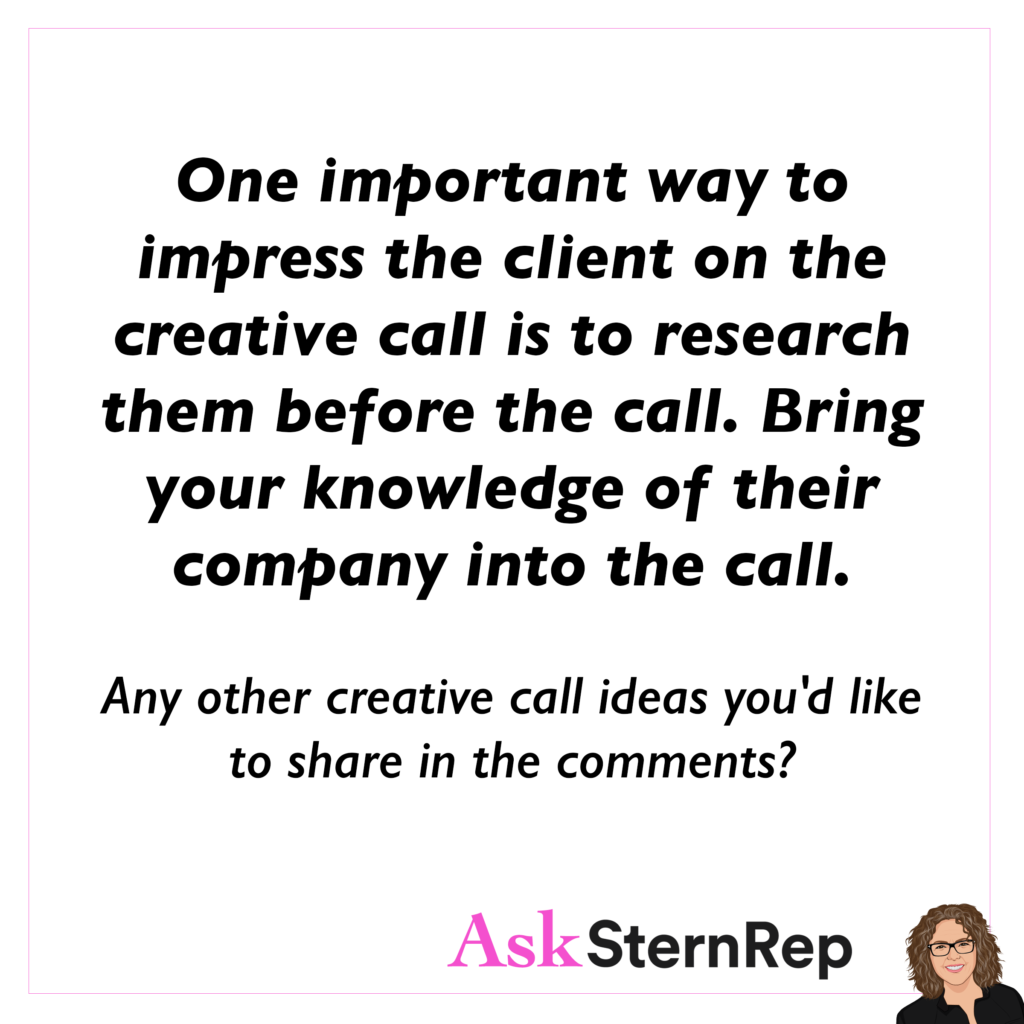
One important way to impress the client on the creative call is to research them before the call. Bring your knowledge of their company into the call.
Any other creative call ideas you’d like to share in the comments?

One important way to impress the client on the creative call is to research them before the call. Bring your knowledge of their company into the call.
Any other creative call ideas you’d like to share in the comments?

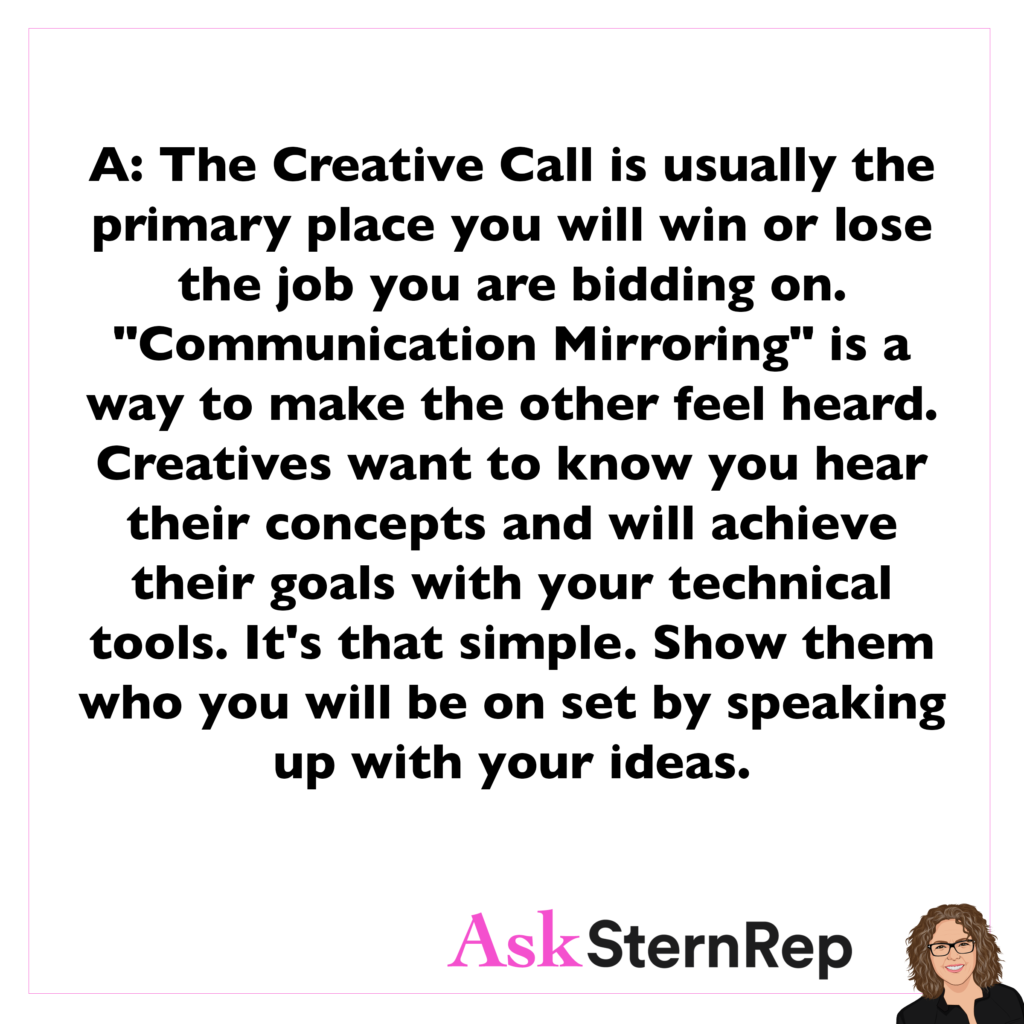
What is the key to having an amazing creative call? What will make you stand out above the other photographers running for that job?
The Creative Call is usually the primary place you will win or lose the job you are bidding on. “Communication Mirroring” is a way to make the other feel heard. Creatives want to know you hear their concepts and will achieve their goals with your technical tools. It’s that simple. Show them who you will be on set by speaking up with your ideas.
Take that Creative Call as the opportunity to close the deal and get the job. Show up as you would in any conversation. Be present and respond by sharing your opinions/thoughts/ideas/excitement throughout the call. They are wondering who you are, and this is your opportunity to give them a sense of who you would be on set.
The creative call is a crucial part of the process for getting a job in the commercial advertising industry. While the treatment, bidding, and portfolio are important, the creative call is when the potential client wants to interact with the photographer and see what kind of person they will be on the shoot. During the call, it is important to listen carefully to the shot list and other details, but also to be ready to jump in and express ideas or technical knowledge. Sharing personal experiences or perspectives on camera angles, fashion, coloring, lighting, and other aspects of the shoot can demonstrate creativity, passion, and professionalism. The creative call is an opportunity to showcase who the candidate will be on set and how they can contribute to the success of the project.
Let’s learn from my mistake. A client’s fast turnaround request for a creative call to review their creative deck had us moving quickly, assuming the bid would be due shortly after that. Why wouldn’t we start the treatment asap? Days later, I knew it was a false alarm when I didn’t hear a peep about the bid specs. Very reputable client, so no funny business, just me reacting too fast with many assumptions. Their creative call was to choose their three bidders. Lesson learned.
A lesson learned from a missed opportunity to bid on a job in the creative industry due to a lack of bid specs. We received at the last minute a request to bid on a job, but did not receive bid specifications until after we had already spent time and money on creating a treatment. Ultimately, the client chose other photographers to bid on the job, leaving us with wasted resources. The lesson learned is that without bid specs, one may not actually be officially bidding on a job.
Once your foot is in the triple bidding door, the creative call has the most impact on landing you the job. Listen for the moments to interject, not based on their inviting pause, but because you relate or understand the scene they are describing and know how to make it happen.
The most important way to stand out in a job interview, especially in the creative industry, is through the creative call. It is an opportunity for you to showcase your ideas and connect with the client on their story and concept. The portfolio and bid are important but the creative call is where you can have the most influence as you’re on the call with them and able to share your ideas and add to their story. Clients want to hear your ideas being added to their own and want to know that you will join them in bringing their vision to life. It’s important to speak up and share your thoughts and ideas, whether it’s through a question or a statement. This is where you can show how you think and stand out from other candidates.
Creative calls are the one bidding opportunity to be human to human.
Clients want a sense of you; even if they already know you, they will want a clear grasp of how you perceive this project. An expression is not always through your comments, as you may be listening to the majority of the call. Be the active listener as they will hear your reactions of nodding in agreement and overall upbeat presence.
The creative call is your chance to grab the client’s attention—it’s one of the three key ways to secure the job you’re bidding on. How do you make the most of it?
Create a strong presence, as if you’re sitting across from them at a table. React and respond actively, mirroring their cues to connect on a personal level. Tilt your head, smile, and maintain eye contact to show you’re engaged. Avoid looking bored, tired, or distracted. Use this opportunity to capture their attention and increase your chances of getting the job.

Photographers in the commercial advertising industry can face complex unmapped territory, especially when invited by a client to submit a bid to get a job. Photographer’s agents are the trusted resource supervising every step of the bidding process to ensure it goes smoothly, helping land the job. Finding a rep to help with bidding negotiation can get tricky; we here at AskSternRep are all about demystifying the photography business, so our team sat down with our founder and photographer’s representative of SternRep, Andrea Stern, for a Q&A on Freelance Temporary Representation.
Andrea Stern: “Temp Rep” is how I join forces with un-repped photographers on a per-project or per-client basis when they want a rep’s help on their bid request, image licensing rights, copyright ownership, reuse, or renewal fees. Whether a photographer only needs me behind the scenes for advice or wants me to be their voice communicating the negotiation with the client, I bring my 100% dedication to treating each case with my utmost attention.
Temporary Representation is how I jump in to be on the photographer’s side wherever they need it. I’ll oversee the bidding process, assessing our needs to get this job. Do you have the right producer, or will we create the bid for you to produce your job? Are we getting all the correct information from the client to support an accurate estimate? Are your bid terms clear and set up to protect you on this specific production? Let’s make the best of the creative call and your treatment without leaving any money on the table when we land this job.
I charge a commission on the photographer’s fees between 15 – 25% only if we get the job. No charge if we don’t get the job; I get paid if you get paid.
Andrea Stern: Temp Repping created itself in 2015 when photographers who knew me started reaching out, needing a freelance rep as they didn’t want to negotiate jobs independently. At the same time, it worked on both ends of the business as client-direct brands and producers started reaching out with mass searches for photographers for a specific project. When I could be helpful on both sides, it was easy to do what I enjoy most no matter what the configuration looked like – I rep photographers to help them get the job. The commercial advertising business started shifting this way, where broader doors were opening, making it easier for un-repped photographers to get their foot in the door.
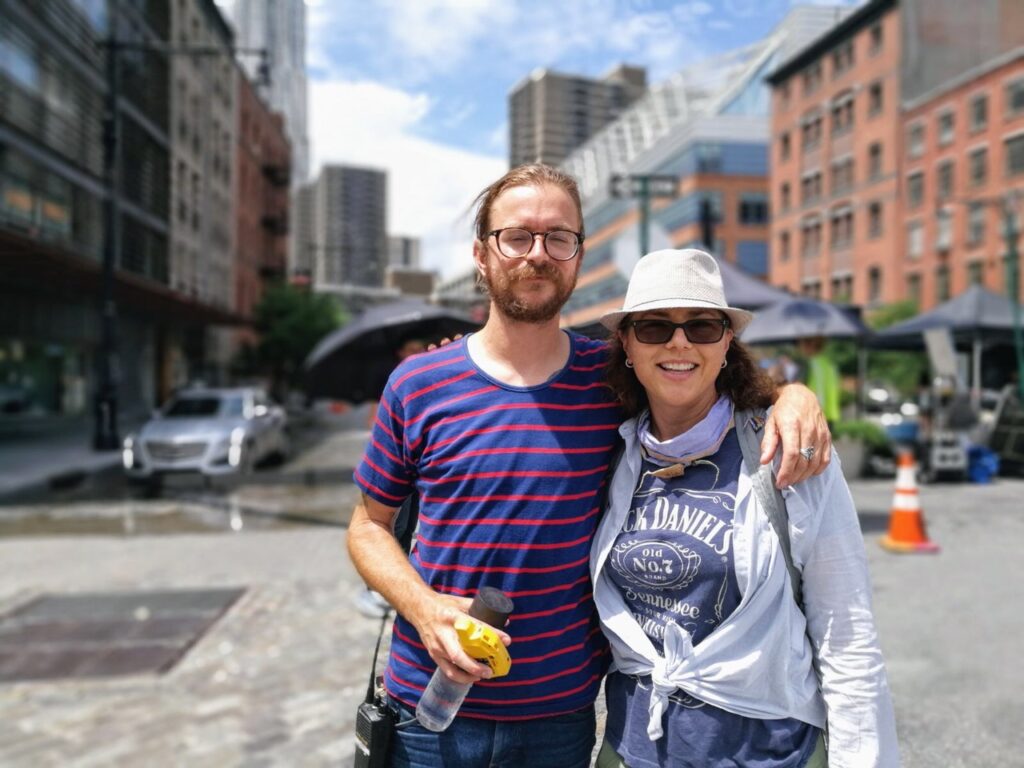
Andrea Stern: Over the years, it’s become a regular recurring position as many photographers can use a rep temporarily. These mainly happen not on a one-time basis but more of an ongoing relationship we are building. It’s a great way to get to know the specifics of each photographer and how they work.
I have worked with over 100 un-repped photographers bidding with clients, including Magnolia Bakery, Sonic Drive-In, Audi, HGTV, Chevy, Merrell, NFL, Adidas, ESPN, Sunbrella, DirectTV, Jack Daniels, State Farm, Delta, Pacifico, HP, Lexus, Target, Disney, Purina, Airbnb, Priceline, Timberland, Darigold, Chase Bank, Bosch, Duluth Trading Co, and Title Nine.
Andrea Stern: Almost every job I bid on with my photographers involves a team, as that is how our business works. When bidding on a project that feels over a photographer’s head regarding ease, communication, finances, and production, they should always involve support. Clients may get nervous if it’s a more significant production and the photographer is on their own.
The benefits of having an agent represent a photographer in our commercial advertising industry are endless if you can trust the Rep you are working with. A representative offers solid protection on the bidding process by overseeing terms, treatment editing, etc., and will get them paid fairly. It astonishes me that every photographer wouldn’t seek a rep’s help on every bid.
Andrea Stern: When a photographer is asked to bid on a job, the first thought should be to consider whether they should bring in a rep. If they’re unsure whether it’s worth it to bring in an agent, some great questions photographers can ask themselves are:
Andrea Stern: When you receive a bid request, you should first decide if you want a rep to work with you on it before even responding. If we are representing you, we should be there from the start, as it’s well worth our commission to warm up the relationship with the client from the get-go. The more seamless the bidding process communication will be as soon as you get the agent involved.
Andrea Stern: Clients familiar with reps are the ad agencies, and clients who tend to be unfamiliar with agents are smaller client brands with in-house marketing. I’ve seen how the type of client can affect the bidding process, so this goes into our team planning strategy before we move forward. Not to boast, but I haven’t met a client I can’t warm up quickly. I accept this challenge as one of my skill sets, where I begin with a soft and personal tone breaking that age-old harsh reputation that agents can have. However we approach this, it is a discussion where we consider the pros and cons, coming up with our game plan together.
Andrea Stern: Generally, budget is not my deciding factor as to who I will Temp Rep; it is more about the type of industry. I’m unfamiliar with editorial, fashion, publication, or photojournalism rates, so I would not feel as helpful as I do with commercial advertising projects, so I stick with those.
Andrea Stern: No, the more times I work with a photographer, the better. I become more comfortable the more we work together. I base a lot of my negotiation on how that photographer works, so getting to know them more only helps me give more to each project.
Andrea Stern: Yes! A couple of my Temp Repping situations have turned into full-time repping. Vinnie Finn, for example, started that way. Vinnie called me to help bid on a wine project in Sonoma County and several long-term projects after that. We had a great thing together; the longer we worked together, the more we knew we could do even better by joining forces full-time.
A Temp Rep situation can lead to an official rep engagement – so if a photographer is looking to get a rep, this can be a perfect way to get to know each other.
My suggestion for un-repped photographers is to research reps who match their style and type of clientele, ask around and do your due diligence to create a short list of reps who may be right for you. Get to know each other as we all have unique ways of working; get a rep who speaks accurately for you, even during a stressful job situation.
It’s a big commitment, and I’ve seen photographers regret signing on with reps; don’t rush the process, and make sure you get to know them first.

Andrea Stern: Well, not to sound crass, but we are business minded and here to make money. We have what it takes, so why not put our skillset into action with the right opportunities? A rep does have a reputation to consider, so we want to represent those who will build our clientele and not damage our brand. We do have to be careful as our name goes into these temporary situations, and our company depends on building relationships. After the checks and balances, we will enjoy the opportunity if we can make money with you.
Andrea Stern: The best part of my job is the relationships I create. If I can be helpful to get a photographer paid and well taken care of, then I’m all in. I enjoy selling the photographer with my moment-to-moment negotiation process, looking for ways to solidify the photographer’s relationship with the client. There’s a genuine advocacy to all of this, which is the most enjoyable part about repping- the confidence, belief, and cheering for talented photographers.
Andrea Stern: A photographer I have temporarily represented on a regular basis since 2017 has me listed as the agent to contact directly for incoming requests on their website. I am trusted without much back and forth to make decisions as they know I will get the best done for them. It’s a nice way to work, Temporary Repping but based on a solid long-term relationship.

We were in a situation where a company used two images after the usage rights expired. The client needed to be financially penalized for that unowned usage term and then wanted to extend the usage for three more years. This negotiation was a situation I could get the photographer paid more than they were expecting, which was extremely satisfying to make a successful renewal deal with one of our highest financial payoffs.
I knew I could start with a high rate, as the client wanted to avoid getting into a legal battle for their illegal photography usage rights. We got $140,000 for the two images for (3) years of packaging, social media, print, OOH, and in-store usage. It was fun to shock the photographer with that payment amount and feel that sense of success, but success is much more than that.
This long-term relationship with the photographer stands out to me as a real success because they permitted me to speak freely on their behalf, getting them compensated to the best of my ability. It’s nice to have that trust with photographers who use me as their Temporary Rep, but it doesn’t feel temporary.
Get in touch! Andrea@SternRep.com

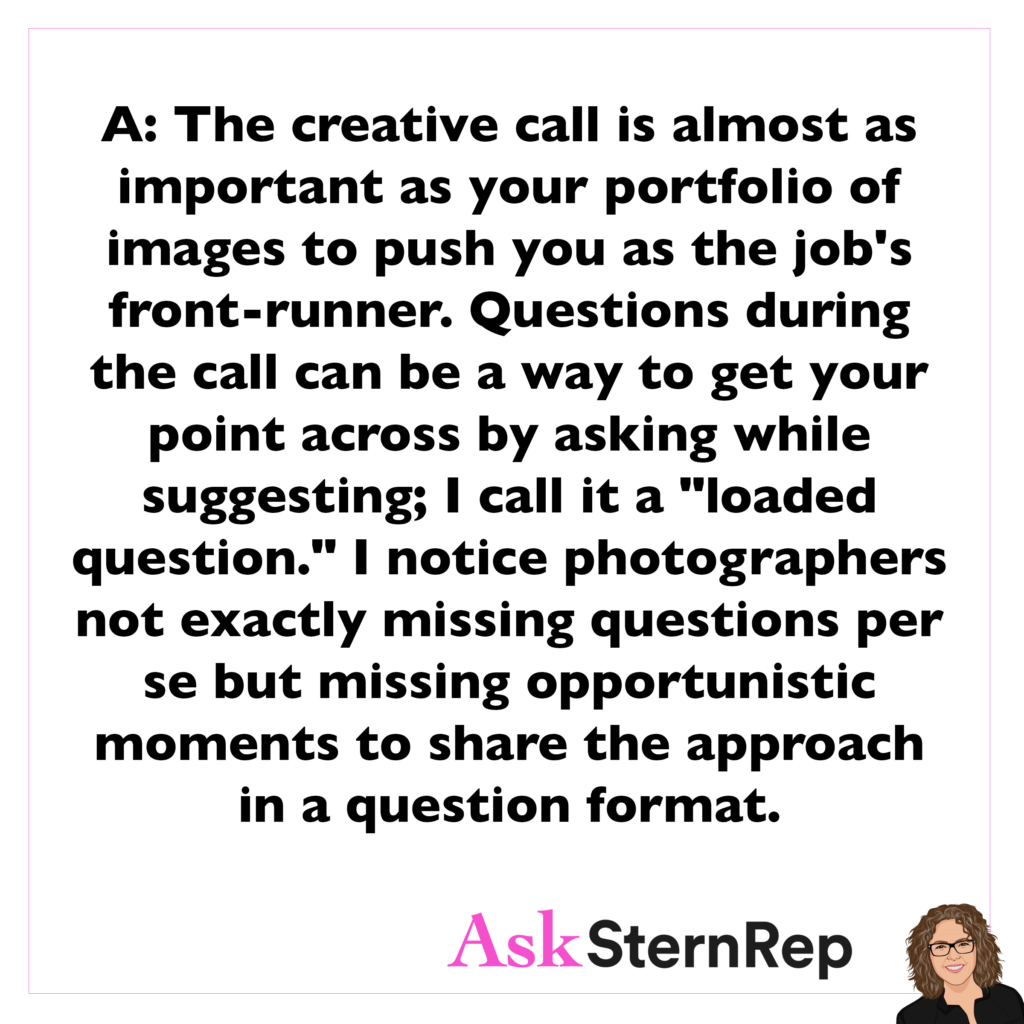
Is there a consistency to questions you feel are missed by the client or photographers on the Creative Call?
The creative call is almost as important as your portfolio of images to push you as the job’s front-runner. Questions during the call can be a way to get your point across by asking while suggesting; I call it a “loaded question.” I notice photographers not exactly missing questions per se but missing opportunistic moments to share the approach in a question format.
Listen for the details mentioned on the creative call like it is a comprehensive test of who you will be on set if they hire you.
The main goal of this call is to show how you hear their vision and put their trust in your hands. If you prove you are not a capable listener by missing the small stuff, you may be blowing their belief that you will hear them on the big stuff.
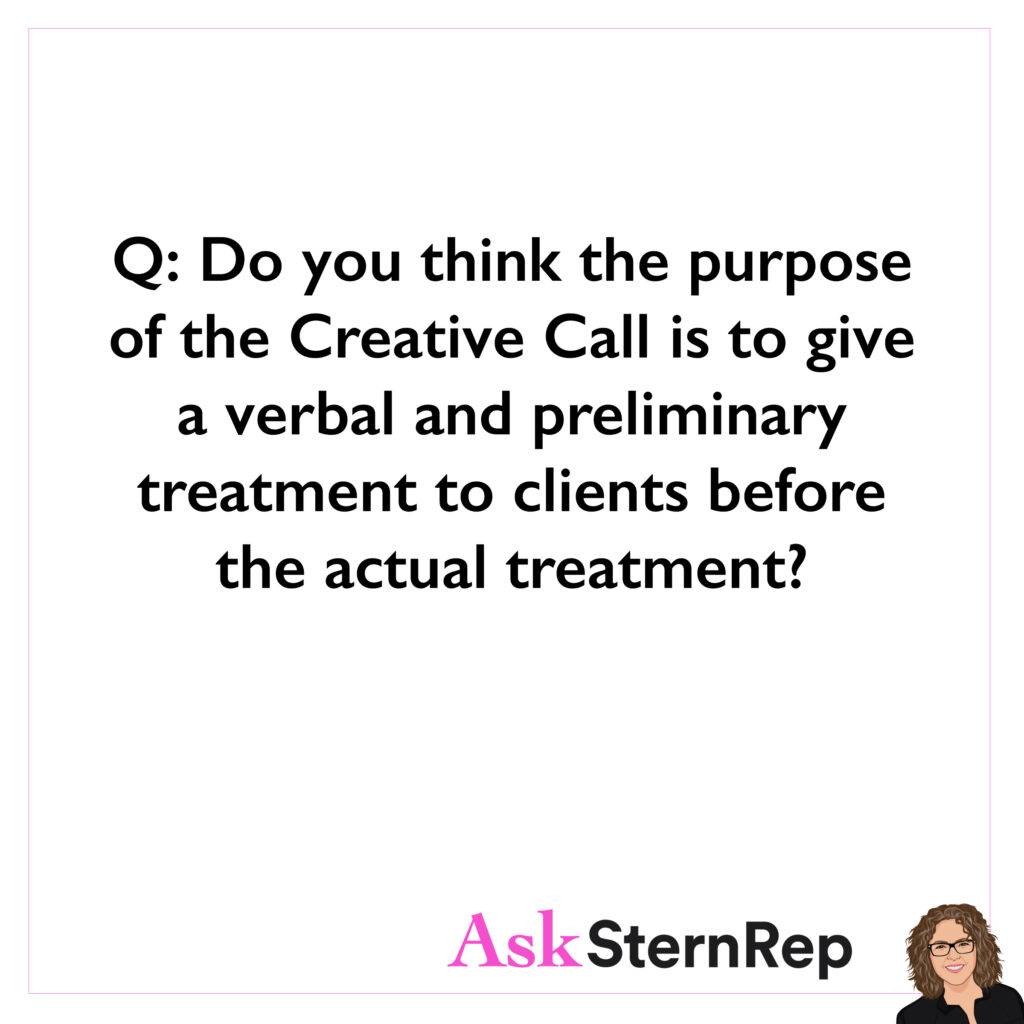
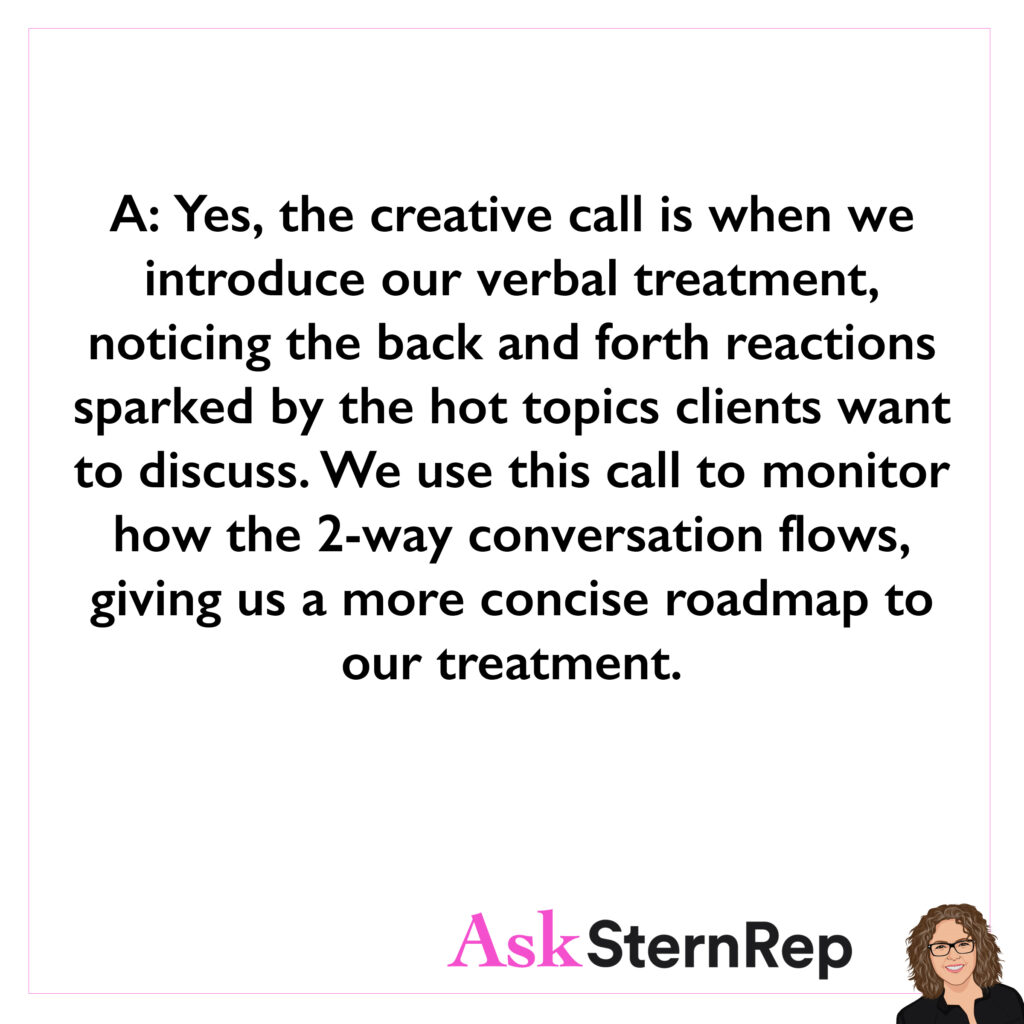
Do you think the purpose of the Creative Call is to give a verbal and preliminary treatment to clients before the actual treatment?
Yes, the creative call is when we introduce our verbal treatment, noticing the back and forth reactions sparked by the hot topics clients want to discuss. We use this call to monitor how the 2-way conversation flows, giving us a more concise roadmap to our treatment.